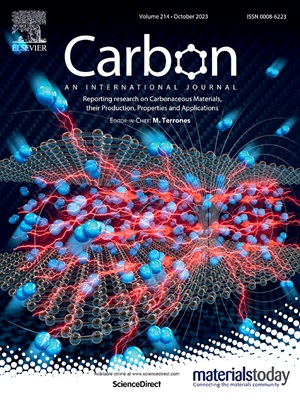Construction of carbon nanotube/graphene composite fibers with excellent dynamic mechanical properties
IF 11.6
2区 材料科学
Q1 CHEMISTRY, PHYSICAL
引用次数: 0
Abstract
Carbon nanotubes (CNTs) are one of the candidates as the basic structural units for manufacturing new high-performance fibers. However, the mechanical properties of carbon nanotube fibers (CNTFs) are far lower than those of single CNTs. Herein, a controllable synthesis route of carbon nanotube/graphene composite fibers from CNTFs was developed. Dense and highly oriented graphene/carbon nanotube composite fibers (G/CNTFs) with high strength and energy absorption were prepared by soaking and assisted stretching with graphene/chlorosulfonic acid (G/CSA) dispersion. Graphene with small diameter and high quality can interlock the carbon nanotube (CNT) tube bundle, prevent crack propagation when the fiber breaks, and endow the fiber with high strength (3.05 GPa) and high energy absorption (109.6 MJ m−3) at high strain rate. The flexibility of G/CNTFs, coupled with the high strength, energy absorption, and conductivity of graphene bridged CNT bundles (2.14 × 106 S/m), positions it as a promising candidate for smart textiles and impact resistant textile materials.

具有优异动态力学性能的碳纳米管/石墨烯复合纤维的构建
碳纳米管是制造新型高性能纤维的基本结构单元之一。然而,碳纳米管纤维(CNTFs)的力学性能远低于单个碳纳米管。本文提出了一种以碳纳米管为原料合成碳纳米管/石墨烯复合纤维的可控路线。以石墨烯/氯磺酸(G/CSA)为分散体,通过浸渍和辅助拉伸制备了致密、高取向、高强度、高吸能的石墨烯/碳纳米管复合纤维(G/CNTFs)。小直径、高质量的石墨烯可以使碳纳米管(CNT)管束互锁,防止纤维断裂时的裂纹扩展,使纤维在高应变速率下具有高强度(3.05 GPa)和高能量吸收(109.6 MJ m−3)。G/ cntf的灵活性,加上石墨烯桥接CNT束的高强度,能量吸收和导电性(2.14 × 106 S/m),使其成为智能纺织品和抗冲击纺织材料的有前途的候选者。
本文章由计算机程序翻译,如有差异,请以英文原文为准。
求助全文
约1分钟内获得全文
求助全文
来源期刊

Carbon
工程技术-材料科学:综合
CiteScore
20.80
自引率
7.30%
发文量
0
审稿时长
23 days
期刊介绍:
The journal Carbon is an international multidisciplinary forum for communicating scientific advances in the field of carbon materials. It reports new findings related to the formation, structure, properties, behaviors, and technological applications of carbons. Carbons are a broad class of ordered or disordered solid phases composed primarily of elemental carbon, including but not limited to carbon black, carbon fibers and filaments, carbon nanotubes, diamond and diamond-like carbon, fullerenes, glassy carbon, graphite, graphene, graphene-oxide, porous carbons, pyrolytic carbon, and other sp2 and non-sp2 hybridized carbon systems. Carbon is the companion title to the open access journal Carbon Trends. Relevant application areas for carbon materials include biology and medicine, catalysis, electronic, optoelectronic, spintronic, high-frequency, and photonic devices, energy storage and conversion systems, environmental applications and water treatment, smart materials and systems, and structural and thermal applications.
 求助内容:
求助内容: 应助结果提醒方式:
应助结果提醒方式:


